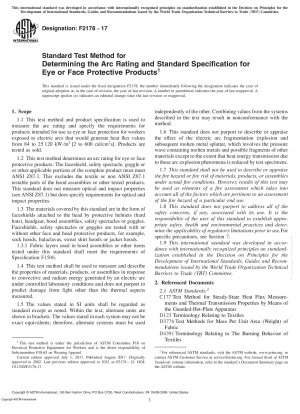ASTM F2178-17(2017)
Standard Test Method for Determining The Arc Rating Of Face Protective Products
- Standard No.
- ASTM F2178-17(2017)
- Release Date
- 2017
- Published By
- American Society for Testing and Materials (ASTM)
- Status
- Replace By
- ASTM F2178-17a
- Latest
- ASTM F2178/F2178M-23a
- Scope
- 1.1 This test method and product specification is used to measure the arc rating and specify the requirements for products intended for use as eye or face protection for workers exposed to electric arcs that would generate heat flux values from 84 to 25 120 kW ⁄m2 [2 to 600 cal/cm2 s]. Products are tested as sold. 1.2 This test method determines an arc rating for eye or face protective products. The faceshield, safety spectacle, goggle or or other applicable portions of the complete product must meet ANSI Z87.1. This excludes the textile or non ANSI Z87.1 testable parts of the hood assemblies or other tested products. This standard does not measure optical and impact properties (see ANSI Z87.1) but does specify requirements for optical and impact properties. 1.3 The materials covered by this standard are in the form of faceshields attached to the head by protective helmets (hard hats), headgear, hood assemblies, safety spectacles or goggles. Faceshields, safety spectacles or goggles are tested with or without other face and head protective products, for example, sock hoods, balaclavas, sweat shirt hoods or jacket hoods. 1.3.1 Fabric layers used in hood assemblies or other items tested under this standard shall meet the requirements of Specification F1506. 1.4 This test method shall be used to measure and describe the properties of materials, products, or assemblies in response to convective and radiant energy generated by an electric arc under controlled laboratory conditions and does not purport to predict damage from light other than the thermal aspects measured. 1.5 The values stated in SI units shall be regarded as standard except as noted. Within the text, alternate units are shown in brackets. The values stated in each system may not be exact equivalents; therefore, alternate systems must be used independently of the other. Combining values from the systems described in the text may result in nonconformance with the method. 1.6 This standard does not purport to describe or appraise the effect of the electric arc fragmentation explosion and subsequent molten metal splatter, which involves the pressure wave containing molten metals and possible fragments of other materials except to the extent that heat energy transmission due to these arc explosion phenomena is reduced by test specimens. 1.7 This standard shall not be used to describe or appraise the fire hazard or fire risk of materials, products, or assemblies under actual fire conditions. However, results of this test may be used as elements of a fire assessment which takes into account all of the factors which are pertinent to an assessment of the fire hazard of a particular end use. 1.8 This standard does not purport to address all of the safety concerns, if any, associated with its use. It is the responsibility of the user of this standard to establish appropriate safety, health and environmental practices and determine the applicability of regulatory limitations prior to use.For specific precautions, see Section 7. 1.9 This international standard was developed in accordance with internationally recognized principles on standardization established in the Decision on Principles for the Development of International Standards, Guides and Recommendations issued by the World Trade Organization Technical Barriers to Trade (TBT) Committee.
ASTM F2178-17(2017) Referenced Document
- ANSI Z87.1-2003 Practice for Occupational and Educational Eye and Face Protection
- ASTM C177 Standard Test Method for Steady-State Heat Flux Measurements and Thermal Transmission Properties by Means of the Guarded-Hot-Plate Apparatus
- ASTM D123 Standard Terminology Relating to Textiles
- ASTM D3776 Standard Test Methods for Mass Per Unit Area (Weight) of Fabric
- ASTM D4391 Standard Terminology Relating to The Burning Behavior of Textiles
- ASTM E457 Standard Test Method for Measuring Heat-Transfer Rate Using a Thermal Capacitance (Slug) Calorimeter
- ASTM F1494 Standard Terminology Relating to Protective Clothing
- ASTM F1506 Standard Performance Specification for Textile Materials for Wearing Apparel for Use by Electrical Workers Exposed to Momentary Electric Arc and Related Thermal Hazards
- ASTM F1958/F1958M Standard Test Method for Determining the Ignitability of Non-flame-Resistant Materials for Clothing by Electric Arc Exposure Method Using Mannequins
- ASTM F1959/F1959M Standard Test Method for Determining the Arc Thermal Performance Value of Materials for Clothing
ASTM F2178-17(2017) history
- 2023 ASTM F2178/F2178M-23a Standard Specification for Arc Rated Eye or Face Protective Products
- 2023 ASTM F2178/F2178M-23 Standard Specification for Arc Rated Eye or Face Protective Products
- 2022 ASTM F2178/F2178M-22 Standard Specification for Arc Rated Eye or Face Protective Products
- 2020 ASTM F2178/F2178M-20 Standard Specification for Arc Rated Eye or Face Protective Products
- 2017 ASTM F2178-17b Standard Test Method for Determining the Arc Rating and Standard Specification for Eye or Face Protective Products
- 2017 ASTM F2178-17a Standard Test Method for Determining the Arc Rating and Standard Specification for Eye or Face Protective Products
- 2017 ASTM F2178-17(2017) Standard Test Method for Determining The Arc Rating Of Face Protective Products
- 2012 ASTM F2178-12 Standard Test Method for Determining the Arc Rating and Standard Specification for Eye or Face Protective Products
- 2008 ASTM F2178-08 Standard Test Method for Determining the Arc Rating and Standard Specification for Face Protective Products
- 2006 ASTM F2178-06 Standard Test Method for Determining the Arc Rating and Standard Specification for Face Protective Products
- 2002 ASTM F2178-02 Standard Test Method for Determining The Arc Rating Of Face Protective Products
